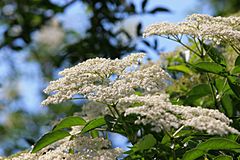Elderberry facts for kids
Elder or Elderberry is the name for several types of shrubs that produce fruit. These fruits are also called elderberries. For a very long time, people have used elderberries for their health benefits.
Ancient Greeks, like Hippocrates (often called the "father of medicine"), used elderberry plants as their "medicine chest" because they seemed to help with many different problems. Records from Ancient Egypt also show recipes for elderberry medicines. Over many centuries, elderberry has been used to treat colds, flu, fevers, and even minor cuts.
Black Elderberries are packed with special things called anthocyanins. These are a type of flavonoid, which are powerful antioxidants. Antioxidants help protect your body's cells and support your immune system. Black Elderberries have almost five times more anthocyanins than blueberries and twice the antioxidant power of cranberries! Some studies even suggest black elderberry has a stronger effect against viruses than Echinacea.
Quick facts for kids Elder or Elderberry |
|
|---|---|
 |
|
| Black Elder (Sambucus nigra) | |
| Scientific classification | |
| Kingdom: | |
| Division: | |
| Class: | |
| Order: | |
| Family: | |
| Genus: |
Sambucus
|
Contents
Growing Elderberry Plants
Many people grow different types of Sambucus plants in their gardens. They are popular because of their pretty flowers, tasty fruits, and delicate leaves. People also plant native elderberry species to help local butterflies and birds, as these plants provide food and habitat.
Elder plants often grow well near farms and homes. They like soil that is rich in nutrients. In places like Britain, elder is often used to make hedges because it grows very quickly and can be shaped easily. It can grow almost anywhere as long as it gets enough sunlight.
How People Use Elderberries
Elderberry for Health
Elderberry fruit or flowers are often used as dietary supplements. People take them for minor illnesses like the flu, colds, and constipation. They are often consumed as a tea, a liquid extract, or in a capsule form.
Elderberry Nutrition Facts
Raw elderberries are mostly water (about 80%). They contain carbohydrates (about 18%) and small amounts of protein and fat. A 100-gram serving of elderberries has about 73 calories. They are a great source of vitamin C, providing 43% of the Daily Value you need each day. Elderberries also have good amounts of vitamin B6 (18% DV) and iron (12% DV).
Elderberry in Food and Drinks
Elderberries and elderflowers are used in many delicious ways around the world.
In France, Austria, and Central Europe, people make elderflower syrup. This sweet syrup, made from elderflower blossoms, is sometimes used in pancakes instead of blueberries. Across Central, Eastern, and Southeastern Europe, a similar syrup is made. It's then mixed with water to create a refreshing drink or used to flavor other foods. In Germany, you can find yogurt desserts made with both elderberries and elderflowers.
Fruit pies and relishes are also made with elderberries. In Italy, Germany, and Austria, the flower clusters of the elderberry are dipped in batter, fried, and served as a dessert. This dish is often topped with sugar and cinnamon and is known as "Hollerküchel."
Every year in May and June, Romanians make a traditional fizzy drink called "socată" or "suc de soc." It's made by soaking elderflowers with water, yeast, and lemon for a few days. The final step of fermentation happens in a closed bottle, which makes it bubbly. This drink even inspired Coca-Cola to create an elderflower-based drink called Fanta Shokata!
The flowers of the Sambucus nigra are also used to make elderflower cordial, a sweet syrup. Some alcoholic drinks, like St-Germain liqueur and Hallands Fläder (a Swedish akvavit), are flavored with elderflowers. Even though it sounds similar, the Italian liqueur sambuca is mostly flavored with star anise, but it does include elderflower extracts to give it a smoother, floral taste.
Hollowed-out elderberry twigs have also been traditionally used as small tubes to tap maple trees for syrup.
Elderberry and Nature
Elderberries are a very important food source for many birds. In Northern California, migrating band-tailed pigeons love elderberries so much that a flock can eat all the berries from a bush in less than an hour!
Elder plants are also food for the larvae (caterpillars) of some Lepidoptera species, which include moths and butterflies. Some examples are the brown-tail moth, buff ermine, and emperor moth. The crushed leaves and young fruit of the elder plant have a strong, unpleasant smell.
The Valley elderberry longhorn beetle in California is often found near red or blue elderberry bushes. Female beetles lay their eggs on the bark, and when the larvae hatch, they burrow into the stems.
Dead elder wood is a favorite place for a mushroom called Auricularia auricula-judae, also known as "Jew's ear fungus," to grow. The soft inside part of the elder's stem, called the pith, has even been used by watchmakers to clean their tools before doing very detailed work.
Images for kids
-
Sambucus canadensis flowers
-
Dried elderberries ready for steeping
See also
 In Spanish: Sambucus para niños
In Spanish: Sambucus para niños








